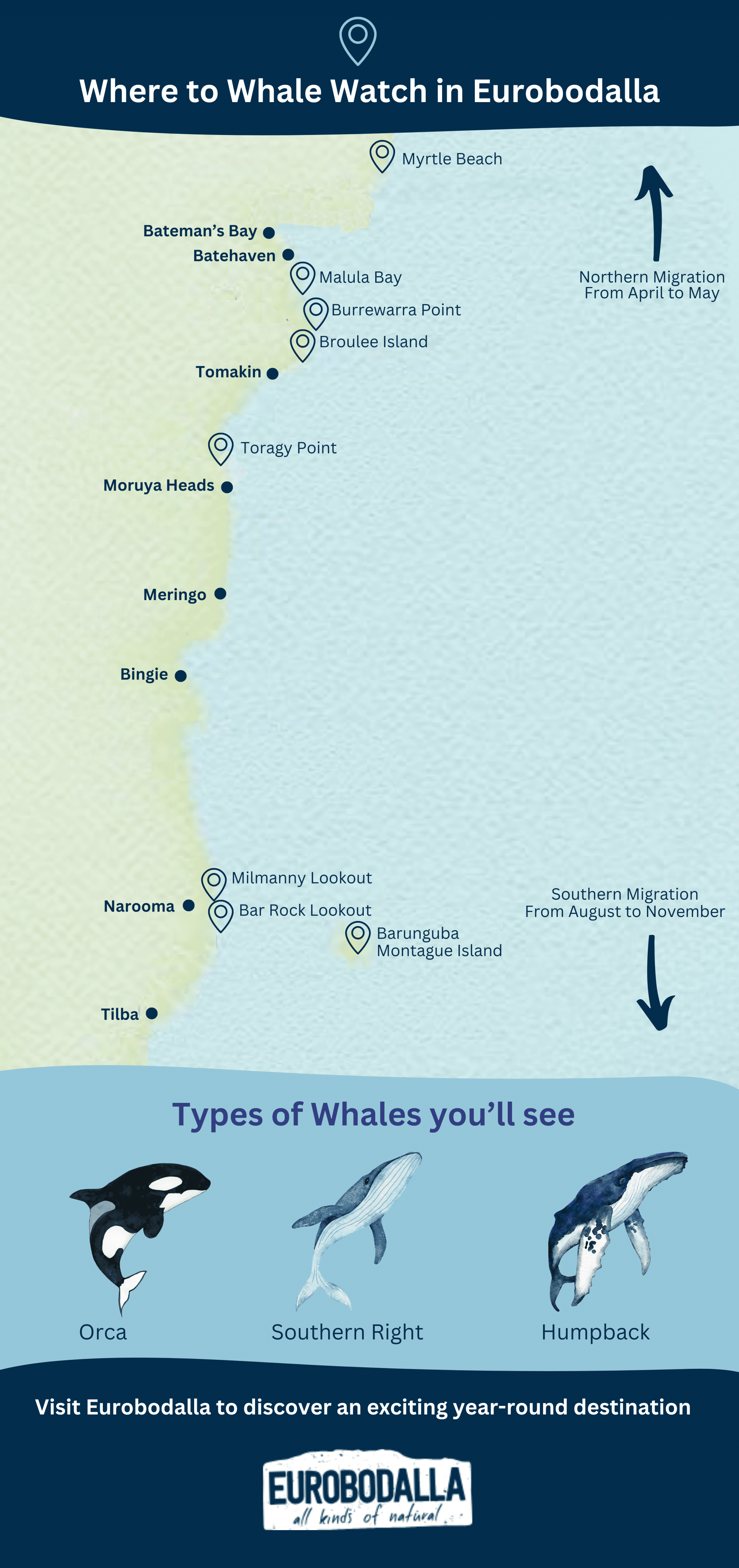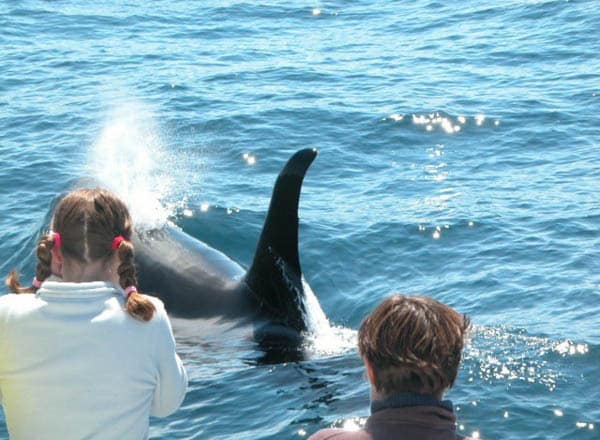Boasting an unspoiled coastline, pristine beaches, and spectacular marine parks, the region becomes one of the country’s biggest stages for whale watching in Eurobodalla. Across various vantage points and headlands overlooking natural harbours, you have some of the best opportunities to view nature’s biggest acrobats up close and dancing past the breakers as they make their way up and down the NSW coastline during their twice-yearly migrations.
For travellers, nature enthusiasts, and adventure seekers alike, a trip to Eurobodalla is a must-see for viewing some of the planet’s largest mammals that have ever lived in their natural habitat. To give you the best chance to see a whale or a pod slapping and hopping, make our article your personal guide to view a spectacular whale migration in Eurobodalla.
To help you maximise your chance of seeing whales breaching the surface, read on to find out the best whale watching spots in Eurobodalla. We cover which species you’re more likely to see and when the best time of year is to visit when they’re more active. Whether you prefer to tour solo and need some information on responsible whale watching practices or want to join an organised excursion with some of the top-rated tour companies, our article has everything you need to make sure you end the day with a few sightings, photos and a smile.
Why Eurobodalla is a prime destination for whale watching
For most people, being able to witness a whale in person is a bucket list activity — one that you’ll be able to soon cross off, with over 35,000 whales migrating past the NSW coast every year.
Whales migrate because their feeding and breeding grounds have separated, causing them to perform one of the longest migrations of any animal on the planet. Every year, whales leave the frigid waters of Antarctica to swim, dive, and frolic north to the warmer waters of the South Pacific Ocean to breed.
Whales make a speedy migration north to breed in the warmer waters closer to the equator. Their return journey south is markedly slower, giving you the best chance for late winter and spring whale watching.
The slower pace is mainly because newborn whales have yet to develop the layers of fat needed to insulate them against the glacial Antarctic water. During their southerly journey, calves suckle from their mothers for nourishment and spend extra time closer to the safety of the shore. As a result there is more chance to see them, especially between Malua Bay and Barunguba Montague Island.

Types of whale species in Eurobodalla
During the peak of the season, when it’s the best time to catch the whale migration in Eurobodalla, a number of different whale species can be spotted as they journey along the coast. Humpback Whales and the Southern Right Whale, both known for their impressive size and acrobatic displays, are usually the most frequently spotted.
Humpback Whales feature a distinctive knobbly head and long pectoral fins. They are particularly famous for their spectacular breaches, where they leap out of the water and crash down with an almighty splash. Southern Right Whales, identified by their lack of a dorsal fin and V-shaped blowhole, are a common sight along Toragy Point and Bar Rock Lookout.
Occasionally, lucky observers might also spot other whale species in Eurobodalla. Orcas (killer whales), are actually the largest member of the dolphin family. Other species known to scuttle past include Bryde’s whales, strapped-toothed whales, and southern minke whales.


Other marine life you can see
In addition to whale watching, Eurobodalla’s rich biodiversity gives you multiple chances to see nature up close in person. From sunbathing fur seals on the breakwalls of Narooma to Little Penguin colonies on Barunguba Montague Island, and dolphins darting through waves, a maritime safari is on the doorstep all year round.
Best times of the year for whale watching
Whale watching in Eurobodalla is a fun-filled activity for the whole family. You can start to see them in late April when they begin their migration north after spending summer eating krill in Antarctic waters. But for more spectacular sightings, lock in August for late winter whale watching and September to November for peak spring whale watching. Pods, led by males and flanked by pregnant and nursing whales (cows) and calves, spend more time swimming and socialising closer to the shore at this time of year.
You can encounter whales at any time, but the morning and afternoon are the optimal times when they’re most active. For early risers, you can start to spot whales at sunrise when the ocean may be calmer, and they begin to feed. Throughout the day and by sunset, you might see them socialising and playing where they breach the water, spy-hopping (rising vertically out of the water) or fluking (lifting their tail out of the water as they dive).
The good news is that as whale populations increase, the whale watching season gets longer and more active, so you may get to see multiple sightings whether you’re visiting for a day, weekend, or a week.
Best whale watching spots around Eurobodalla
Finding a vantage spot with a high elevation gives you the best chance to view various whale species from land. With many headlands and lookouts dotted along the Eurobodalla coast, you’re never too far from a hotspot for whale watching. Some you should check out include:
- Myrtle Beach — For a half or full-day adventure, Myrtle Beach offers spectacular panoramic views of the natural vista. Walk the two-kilometre return trail to Wasp Head, where you pass through Indigenous sites and enjoy a picnic while waiting for whales to pass from this stunning location.
- Malua Bay — Take a trip to South Head for some of the best opportunities to view whales up close, sometimes 150 metres from the headland. You can access South Head by Tallawang Avenue, Malua Bay, before following a short trail from clearings at the north and south of the headland. Please note there is limited parking.
- Burrewarra Point — If you like to get off the beaten path, take the Guerilla Bay turnoff onto Burri Point Road and follow a signposted trail through banksia forest. With views of the hinterland to complement some hours spent whale watching in Eurobodalla, you can take home memories of your time immersed in nature.
- Broulee Island — It has been a long time since Broulee served as a depot for Jervis Bay’s whaling fleet. Today, the area offers a great spot for scanning the water for humpbacks and joining a snorkelling tour. While visiting, you can also explore the remnants of heritage buildings that date back as early as 1850.
- Toragy Point — If you’re short on time, Toragy Point is primely located less than a 10-minute drive from Moruya. It offers a rich natural landscape for you to explore as you try to get a glimpse of the biannual whale migration in Eurobodalla.
- Bar Rock Lookout — Get here early to secure one of the best and most popular positions for viewing whales, seals and dolphins.
- Barunguba Montague Island — Make the most of your time in Eurobodalla and explore Montague Island, a destination unlike any other. After a 25-minute boat ride, you have a whole day of exploring an island that doubles as a national park. After visiting two restored lighthouse cottages, settle down close to shore and enjoy front-row seats to take in stunning 360° views of the entire region as you survey the water for whales and seals.
Best whale watching tour companies
Whether you’re looking to make the most of an exciting day trip or designing a holiday itinerary for making memories, certain vantage points can’t be accessed by land or without the help of an expert guide.
Organising a tour by sea or plane can be a rewarding experience as you join a seasoned and licensed operator who can share their expert knowledge of whales and the region. While whale sightings aren’t always guaranteed, many professional tours will scout the region beforehand so they can take your tour group directly to where they have been seen.
For a list of tour operators who follow responsible whale watching practices, consider the following companies:
- Region X — Known for taking a slower approach to travel, allowing you to immerse yourself in the environment, Region X offers half-day kayak tours that provide the chance to see whales from a perspective most people never have.
- South Coast Seaplanes — Operating out of Moruya and Narooma, you can choose from their established packages or contact them for a custom itinerary that lets you get a birds-eye view of the entire region as you search for an elusive humpback whale.
- Whale Watching from Narooma — The peak whale-watching location boasts several reputable tour companies with various cruising styles and activities to satisfy everyone. Choose a combination tour that allow you to fish, snorkel and whale watch as you take in the brilliant views while sailing on a catamaran or a purpose-built fishing and touring vessel.
Responsible whale watching practices
Like all marine life, whales can be unpredictable — particularly if they migrate with young calves. To ensure your safety and the welfare of the whales, which are a protective species, it’s essential that you, your group and your chosen tour group company follow some common sense and responsible whale watching practices.
The NSW Government’s Environment and Heritage office recommends staying at least 100m away while swimming and snorkelling and 300m away while on a boat or surfboard. They also recommend that you observe them from the side and don’t impede their travels, including not chasing them from behind or waiting ahead of them.
For people using a drone, you need to keep a 100m radius clear of them and maintain a 300m and 500m distance while touring in a fixed-wing aircraft and helicopter.
Marine conservation in Eurobodalla
To preserve the corridors whales migrate in and the region’s natural beauty, the Eurobodalla Shire Council and other organisations manage various programs to help eliminate marine debris and regenerate areas, ensuring nature is left in a better condition than it was found.
Programs such as the Marine Debris Working Group and Clyde the Little Penguin Project work to minimise the harm rubbish causes marine life and their habitats. Local conservation programs often involve the community, with residents and visitors encouraged to participate in beach clean-ups, wildlife monitoring, and using fishing tackle debris bins.
What to bring during whale watching expeditions
For a successful and comfortable experience whale watching in Eurobodalla, it’s important to come prepared. Here’s a checklist of essentials:
- Clothing — Dress in layers with waterproof outerwear that will protect you from windy headlands and changing weather. Wear a hat and 50+ SPF for effective sun protection, whether you have blue or overcast skies.
- Photography Equipment — You’ll want to remember the special moment you saw a humpback crowning and breaching the water. Don’t forget to bring and fully charge your phone or digital camera, and consider a gimbal to mount your camera for improved image stabilisation.
- Binoculars — A pair of binoculars can make all the difference for spotting whales at a distance, especially when watching from the shore.
Eurobodalla — Your destination for whale watching on the NSW south coast
From Batemans Bay to Moruya, Narooma and beyond, Eurobodalla is a year-round holiday destination packed with activities for a weekend or fortnight.
Visit today and enjoy one of Australia’s premier locations for witnessing awe-inspiring whale migrations between sampling local artisanal produce at local restaurants and markets and exploring museums and other cultural institutions.
